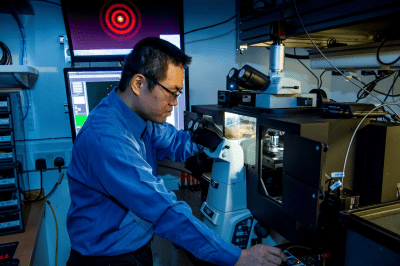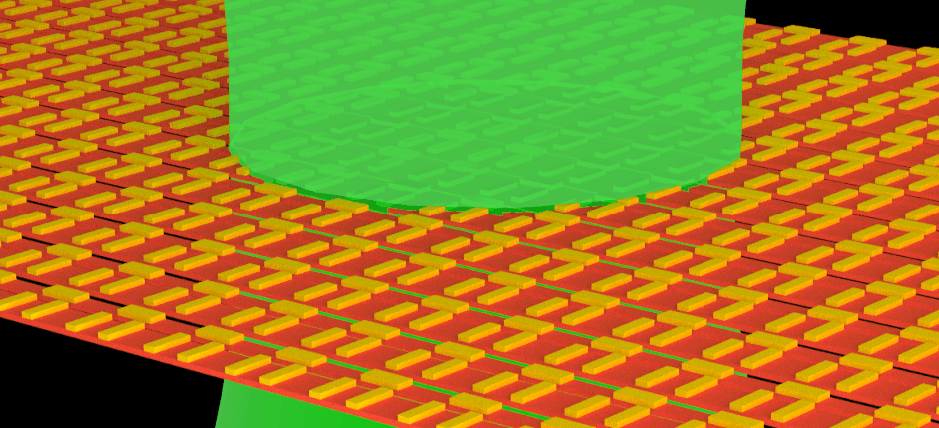The spiral phase contrast microscope can clearly distinguish the morphological information of the low contrast objects (i.e., biological samples) owing to the isotropic edge-enhancement effect, while the bright field microscope can image the overall morphology… More
Featured Research
Photonic metamaterial analogue of a continuous time crystal Nature Physics (2023)
Time crystals are an eagerly sought phase of matter with broken time-translation symmetry. Quantum time crystals with discretely broken time-translation symmetry have been demonstrated in trapped ions, atoms and spins whereas continuously broken time-translation symmetry has been observed in an atomic condensate inside an optical cavity. Here we report that a classical metamaterial nanostructure, a two-dimensional array of plasmonic metamolecules supported on flexible nanowires, can be driven to a state possessing all of the key features of a continuous time crystal: continuous coherent illumination by light resonant with the metamolecules’ plasmonic mode triggers a spontaneous phase transition to a superradiant-like state of transmissivity oscillations, resulting from many-body interactions among the metamolecules, characterized by long-range order in space and time. The phenomenon is of interest to the study of dynamic classical many-body states in the strongly correlated regime and applications in all-optical modulation, frequency conversion and timing.
Photonic metamaterial analogue of a continuous time crystal
T. Liu, J. Y. Ou, K. F. MacDonald, and N. I. Zheludev
Nat. Phys. (2023) doi: 10.1038/s41567-023-02023-5 [Press coverage]
Detection of sub-atomic movement in nanostructures Nanoscale Advances(2021)
Nanoscale objects move fast and oscillate billions of times per second. Such movements occur naturally in the form of thermal (Brownian) motion while stimulated movements underpin the functionality of nano-mechanical sensors and active nano-(electro/opto) mechanical devices. Here we introduce a methodology for detecting such movements, based on the spectral analysis of secondary electron emission from moving nanostructures, that is sensitive to displace- ments of sub-atomic amplitude. We demonstrate the detection of nanowire Brownian oscillations of ~10 pm amplitude and hyper- spectral mapping of stimulated oscillations of setae on the body of a common flea. The technique opens a range of opportunities for the study of dynamic processes in materials science, nanotechnology and biology.
Detection of sub-atomic movement in nanostructures
T. Liu, J. Y. Ou*, K. F. MacDonald, and N. I. Zheludev
Nanoscale Advances (2021) doi: 10.1039/d0na01068e – pdf
Part of £5.5M Nano-metrology Programme Grant
The UK’s Engineering and Physical Sciences Research Council (EPSRC) has announced funding for a five-year research programme, from Feb. 2021, on NEXT GENERATION METROLOGY DRIVEN BY NANOPHOTONICS. This collaboration between the University of Southampton’s Zepler Institute for Photonics & Nanoelectronics and the University of Huddersfield’s Centre for Precision Technologies will harness the latest advances in nanophotonics, plasmonics and metamaterials research to develop optical metrology tools and measurement techniques that can be deployed in the real-world and novel metrology concepts for nanotechnology.
Work at Southampton will be led by Prof Nikolay Zheludev, Prof Kevin MacDonald, Dr Eric Plum and Dr Jun-Yu(Bruce) Ou. The Programme is supported by project partners including major metrology instrumentation companies Taylor Hobson and Renishaw, as well as QinetiQ, Qioptiq, and academic partners at Nanyang Technological University, Singapore.
Press coverage:
An electromechanically reconfigurable metamaterial operating in the near infrared Nature Nanotechnology (2013)
The first metamaterial electro-optic modulator for the telecommunications band
Current efforts in metamaterials research focus on attaining dynamic functionalities such as tunability, switching and modulation of electromagnetic waves1. To this end, various approaches have emerged, including embedded varactors2, phase-change media3, 4, the use of liquid crystals5, 6, electrical modulation with graphene7, 8 and superconductors9, and carrier injection or depletion in semiconductor substrates10, 11. However, tuning, switching and modulating metamaterial properties in the visible and near-infrared range remain major technological challenges: indeed, the existing microelectromechanical solutions used for the sub-terahertz12and terahertz13, 14, 15 regimes cannot be shrunk by two to three orders of magnitude to enter the optical spectral range. Here, we develop a new type of metamaterial operating in the optical part of the spectrum that is three orders of magnitude faster than previously reported electrically reconfigurable metamaterials. The metamaterial is actuated by electrostatic forces arising from the application of only a few volts to its nanoscale building blocks—the plasmonic metamolecules—that are supported by pairs of parallel strings cut from a flexible silicon nitride membrane of nanoscale thickness. These strings, of picogram mass, can be driven synchronously to megahertz frequencies to electromechanically reconfigure the metamolecules and dramatically change the transmission and reflection spectra of the metamaterial. The metamaterial’s colossal electro-optical response (on the order of 10−5–10−6 m V−1) allows for either fast continuous tuning of its optical properties (up to 8% optical signal modulation at up to megahertz rates) or high-contrast irreversible switching in a device only 100 nm thick, without the need for external polarizers and analysers.
Ref:
An electromechanically reconfigurable plasmonic metamaterial operating in the near-infrared
J. Y. Ou, E. Plum, J. Zhang, and N. I. Zheludev
Nature Nanotech. 8, 252-255 (2013) doi: 10.1038/NNANO.2013.25
Press coverages
Exotic optics: Metamaterial world
Nature: News Feature, Aug 2013 – link
Electrical signals dictate optical properties
Nanotechnology Now, Mar 2013 – link
Electrical Signals Dictate Optical Properties
Science Daily, Mar 2013 – link
Electrical signals dictate optical properties of metamaterial
Laser Focus World, Mar 2013 – link
Metamaterial with adjustable optical properties
R&D, Mar 2013 – link
Variable-property metamaterial has optical application potential
the ENGINEER, Mar 2013 – link
Optomechanical metamaterials with giant nonlinearity Advanced Materials (2016)
The first demonstration of light driven optomechanical metamaterials exhibiting giant nonlinearity in the near infrared.
Metamaterial nanostructures actuated by light give rise to a large optical nonlinearity. Plasmonic metamolecules on a flexible support structure cut from a dielectric membrane of nanoscale thickness are rearranged by optical illumination. This changes the optical properties of the strongly coupled plasmonic structure and therefore results in modulation of light with light.
Ref:
Giant nonlinearity of an optically reconfigurable plasmonic metamaterial
J. Y. Ou, E. Plum, J. Zhang, and N. I. Zheludev
Adv. Mater. 28, 729-733 (2016) doi: 10.1002/adma.201504467







